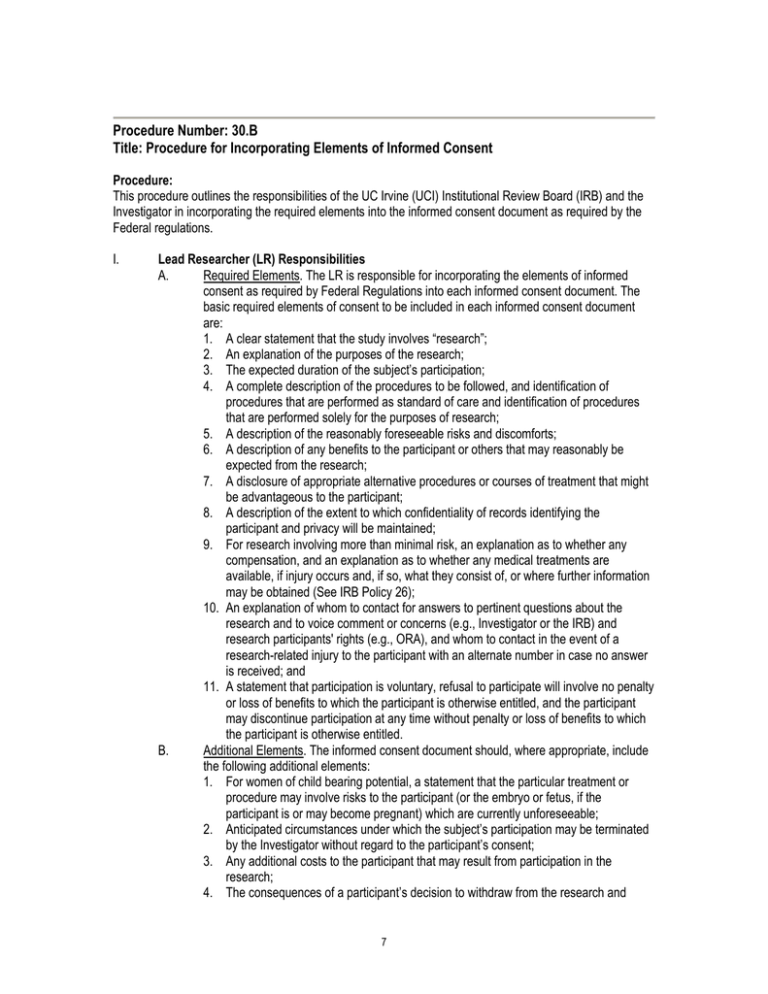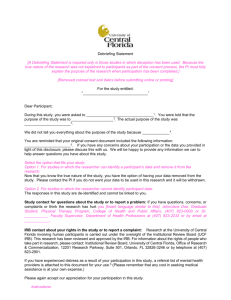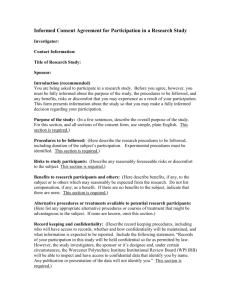Procedure Number: 30.B Title: Procedure for Incorporating Elements of Informed Consent
advertisement

Procedure Number: 30.B Title: Procedure for Incorporating Elements of Informed Consent Procedure: This procedure outlines the responsibilities of the UC Irvine (UCI) Institutional Review Board (IRB) and the Investigator in incorporating the required elements into the informed consent document as required by the Federal regulations. I. Lead Researcher (LR) Responsibilities A. Required Elements. The LR is responsible for incorporating the elements of informed consent as required by Federal Regulations into each informed consent document. The basic required elements of consent to be included in each informed consent document are: 1. A clear statement that the study involves “research”; 2. An explanation of the purposes of the research; 3. The expected duration of the subject’s participation; 4. A complete description of the procedures to be followed, and identification of procedures that are performed as standard of care and identification of procedures that are performed solely for the purposes of research; 5. A description of the reasonably foreseeable risks and discomforts; 6. A description of any benefits to the participant or others that may reasonably be expected from the research; 7. A disclosure of appropriate alternative procedures or courses of treatment that might be advantageous to the participant; 8. A description of the extent to which confidentiality of records identifying the participant and privacy will be maintained; 9. For research involving more than minimal risk, an explanation as to whether any compensation, and an explanation as to whether any medical treatments are available, if injury occurs and, if so, what they consist of, or where further information may be obtained (See IRB Policy 26); 10. An explanation of whom to contact for answers to pertinent questions about the research and to voice comment or concerns (e.g., Investigator or the IRB) and research participants' rights (e.g., ORA), and whom to contact in the event of a research-related injury to the participant with an alternate number in case no answer is received; and 11. A statement that participation is voluntary, refusal to participate will involve no penalty or loss of benefits to which the participant is otherwise entitled, and the participant may discontinue participation at any time without penalty or loss of benefits to which the participant is otherwise entitled. B. Additional Elements. The informed consent document should, where appropriate, include the following additional elements: 1. For women of child bearing potential, a statement that the particular treatment or procedure may involve risks to the participant (or the embryo or fetus, if the participant is or may become pregnant) which are currently unforeseeable; 2. Anticipated circumstances under which the subject’s participation may be terminated by the Investigator without regard to the participant’s consent; 3. Any additional costs to the participant that may result from participation in the research; 4. The consequences of a participant’s decision to withdraw from the research and 7 5. 6. 7. 8. 9. 10. 11. 12. 13. procedures for orderly termination of participation by the subject; a) When a participant withdraws from a study, the data collected on the participant to the point of withdrawal remains part of the study database and may not be removed. The consent document cannot give the participant the option of having data removed. b) A researcher may ask a participant who is withdrawing whether the participant wishes to provide continued follow-up and further data collection subsequent to their withdrawal from the interventional portion of the study. Under these circumstances, the discussion with the participant would distinguish between study- related interventions and continued follow-up of associated clinical outcome information, such as medical course or laboratory results obtained through non-invasive chart review, and address the maintenance of privacy and confidentiality of the participant’s information. (1) The researcher must obtain the participant’s informed consent for this limited participation in the study (assuming such a situation was not described in the original consent form). The IRB approves the consent document. c) If a participant withdraws from the interventional part of the study and does not consent to continued follow-up of associated clinical outcome information, the researcher must not access for purposed related to the study the participant’s medical record or other confidential records requiring the participant’s consent. However, a researcher may review study data related to the participants’ withdrawal from the study, and may consult public records, such as those that establish survival status. A statement that significant new findings developed during the course of the research which may relate to the participant’s willingness to continue participation will be provided to the participant; a) If there are significant new findings, the LR (with Committee input) should update the consent form to include this information and submit the reconsent cover letter to summarize the major changes. The reconsent cover letter template is available on the IRB Forms website. (1) Examples of when reconsenting should be required: (a) Increase in risk; (b) New risks identified; (c) Decrease in anticipated benefits; and (d) Change in research procedures. (2) The IRB will also consider other situations where reconsenting may be necessary (e.g., Change in Lead Researcher). The approximate number of participants involved in the study; Study treatment(s) and the probability of random assignment to placebo or to each treatment; Additional information pertaining to the use of biological materials for research, especially genetic research; A statement noting the possibility that the FDA may inspect the study records; The type and amount of compensation, if any, the participant is to receive for study participation, and the schedule of compensation (i.e., whether it will be pro-rated). Notification of any potential conflict of interest. Any additional information that may be required by state law or institutional policy to obtain legally effective informed consent. The IRB may require that information, in addition to that required in Federal 8 C. D. E. F. G. H. regulations, be given to research participants when in its judgment the information would meaningfully add to the protection of the rights and welfare of participants. No Omission of Required Elements unless a Waiver is granted. Required elements of informed consent may not be omitted unless waived by the IRB (See IRB Policy 32) In addition, there may not be discrepancies within the informed consent documents, the IRB application, the Sponsor’s or Investigator’s Protocol, the Investigator’s Brochure, the grant and/or the contract regarding the purpose, risks, and benefits of the research. The IRB encourages Investigators to use the IRB template informed consent document when developing consent documents. Biomedical and Social/Behavioral templates are available on the IRB website at http://www.research.uci.edu/ora/forms/ under the heading “IRB Consent Forms.” Second Person. The language of the consent documents should be in the second person style (i.e., “you, your”), which may help convey that there is a choice to be made by the participant rather than a presumption of the participant’s consent with the use of the first person style (i.e., “I, me, my”). No Unproven Claims of Effectiveness. No unproven claims of effectiveness or certainty of benefit, either implicit or explicit, may be included in the informed consent documents. No Complex Language. The information provided in the informed consent documents must be in a language understandable to the participant (target population). The informed consent documents should not include complex language that would not be understandable to all participants. Technical and scientific terms should be adequately explained using common or lay terminology consistently. Generic names are preferable when describing pharmaceuticals unless the brand name is more commonly known and understood. Regardless of which name is preferred, it should be used consistently throughout the informed consent documents. Devices and procedures should also be described consistently throughout the documents and explained in simple language. It is generally recommended that the adult consent documents be written at a sixth to eighthgrade reading level. No Exculpatory Language. The informed consent documents may not contain any exculpatory language through which the participant is made to waive or appear to waive any of the participant’s legal rights, or releases or appears to release the investigator, the sponsor, the University, or its agents from liability for negligence. FDA Regulated Test Articles. For all research involving test articles regulated by the U.S. Food and Drug Administration (FDA), informed consent documents should include a statement that a purpose of the study includes an evaluation of the test article. Statements that test articles are safe or statements that the safety has been established in other studies are not appropriate when the purpose of the study includes determination of safety. In studies that also evaluate the effectiveness of the test article, informed consent documents should include that purpose, but should not contain claims of effectiveness. 1. Phase I Studies. Potential participants should be told, and a statement included in the purpose of the informed consent document, that Phase I studies are designed to determine safety, but not effectiveness. They are also designed to determine toxicity, and severe toxicity is a planned event for a subset of participants, and direct benefit is both not intended and extremely unlikely. In addition, the informed consent document should include an explicit statement that the dose administered is not chosen to maximize the chance of effect. 2. Phase II and Phase III Studies. Potential participants should be told, and a statement included in the purpose of the informed consent document, that Phase II and III studies are designed to determine both safety and effectiveness. 9 II. IRB Committee Responsibilities A. The IRB Committee, the Chairperson or his/her designee will review the informed consent documents to assure the documents contain all the required elements of consent as defined by the Federal Regulations and determine the additional elements that are appropriate and should be incorporated into the documents. B. The IRB Committee, the Chairperson or his/her designee will complete the Informed Consent portion of the IRB Reviewer’s Checklist. C. There are two circumstances under which the regulations give the IRB the authority to waive the required consent (See IRB Policy 32) D. The IRB Committee, the Chairperson or his/her designee will review the informed consent documents to assure: 1. There are no discrepancies within the informed consent documents, the IRB application, the Sponsor’s or Investigator’s Protocol, or the Investigator’s Brochure, regarding the purpose, risks, and benefits of the research; 2. The language of the consent document is in the second person style (i.e., “you”); 3. The documents do not contain unproven claims of effectiveness or certainty of benefit, either implicit or explicit; 4. The information provided in the informed consent documents is in a language understandable to the participant population and does not include complex language that would not be understandable to all participants; 5. Informed consent documents do not contain any exculpatory language through which the participant is made to waive or appear to waive any of the participant's legal rights, or releases or appears to release the investigator, the sponsor, the University, or its agents from liability for negligence; 6. For all research involving test articles regulated by the U.S. Food and Drug Administration (FDA), the informed consent document(s) includes a statement that the purpose of the study includes: a. For Phase I Studies: that the study is designed to determine safety, but not effectiveness. They are also designed to determine toxicity, and severe toxicity is a planned event for a subset of participants, and direct benefit is both not intended and extremely unlikely. In addition, the informed consent document should include an explicit statement that the dose administered is not chosen to maximize the chance of effect; and b. For Phase II and Phase III Studies: that the purpose of the study is to determine both safety and effectiveness. III. IRB Analyst or Higher Responsibilities A. The Analyst will conduct a pre-review of the informed consent documents submitted with a new study application to determine that the correct forms have been submitted for the targeted population, assess the readability of the document, and that all required elements are present for adequate informed consent, including if any additional elements are appropriate. B. If additional information regarding the informed consent process or documentation is needed, the Analyst will contact the LR and request the additional information. C. The Analyst will ensure that the IRB Chairperson or his/her reviewers completed the Informed Consent portion of the IRB Reviewer’s Checklist. 10




